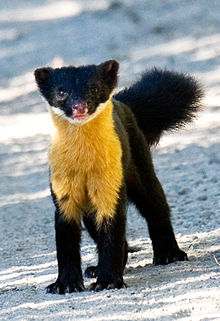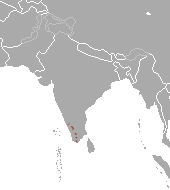| Nilgiri marten | |
|---|---|

| |
| Scientific classification | |
| Domain: | Eukaryota |
| Kingdom: | Animalia |
| Phylum: | Chordata |
| Class: | Mammalia |
| Order: | Carnivora |
| Family: | Mustelidae |
| Genus: | Martes |
| Species: | M. gwatkinsii
|
| Binomial name | |
| Martes gwatkinsii (Horsfield, 1851)
| |

| |
| Nilgiri marten range | |
| Synonyms | |
|
Charronia gwatkinsii | |
The Nilgiri marten (Martes gwatkinsii) is the only marten species native to southern India. It lives in the hills of the Nilgiris and parts of the Western Ghats. With only around a thousand members left it is listed as Vulnerable on the IUCN Red List.[1]
The Nilgiri marten is deep brown from head to rump, with the forequarters being almost reddish, with a bright throat ranging in colour from yellow to orange. It has a prominent frontal concavity and is larger than the yellow-throated marten.[2] It is about 55–65 cm (22–26 in) long from head to vent and has a tail of 40–45 cm (16–18 in). It weighs about 2.1 kg (4.6 lb).[3]: 6 The Nilgiri marten is diurnal. It is mainly arboreal, but descends to the ground occasionally. It is omnivorous and preys on birds, small mammals and insects such as cicadas.[4][2] It has also been observed feeding on a variety of fruits and seeds.[5]
The Nilgiri marten mainly inhabits the shola grassland and high altitude evergreen forests, and occasionally the adjacent mid-altitude moist deciduous forests and commercial plantations, that span the Western Ghats in the South Indian states of Karnataka, Kerala, and Tamil Nadu. The marten's English common name is derived from the Nilgiri Hills that form the center of its range, but sightings have been reported as far north as Charmadi Ghat and as far south as the Neyyar and Peppara Wildlife Sanctuaries.[6][7][8][9][10][11]
The species is named after the collector Reynolds Gwatkins who gave a specimen to Colonel W.H. Sykes and was described by Thomas Horsfield from the skin in the museum of the East India Company.[12]
| Martes gwatkinsii | |
|---|---|
